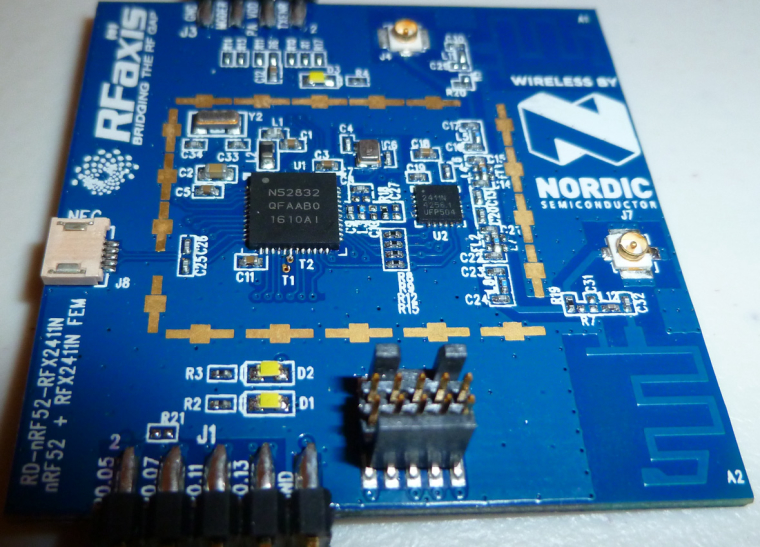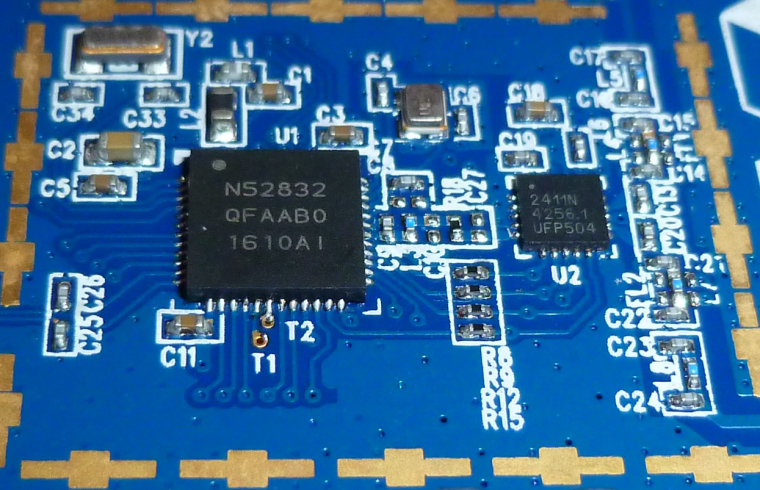nRF5 action!
-
For instance, how hard would it be to create a simple serial bridge so view serial output on your bluetooth phone, the way @sundberg84 is doing with a specialized bluetooth module: https://forum.mysensors.org/topic/6340/debug-to-a-sd-card-module
-
For instance, how hard would it be to create a simple serial bridge so view serial output on your bluetooth phone, the way @sundberg84 is doing with a specialized bluetooth module: https://forum.mysensors.org/topic/6340/debug-to-a-sd-card-module
@NeverDie said in nRF5 Bluetooth action!:
For instance, how hard would it be to create a simple serial bridge so view serial output on your bluetooth phone, the way @sundberg84 is doing with a specialized bluetooth module: https://forum.mysensors.org/topic/6340/debug-to-a-sd-card-module
For similar functionality, there is an MY_DEBUG_OTA feature in MySensors development branch. You can send log messages to any node in the MySensors network.
The NRF5 MySensors port is running directly on the MCU hardware. Using the SoftDevice is like running an Operating System. There are limitations using the Hardware and APIs have to use. You are loosing control over the Radio, some Timers and RTC, Crypto components and the memory layout.
The reason the SoftDevice isn't supported is the old licence model. This model is changed with SDK14.
In my opinion with MySensors 2.x it isn't meaningful to play with the multiplexing of the radio module. I think this requires more changes in MySensors to handle the time when the MCU is in BLE mode.
If you are interested implementing a dual stack software, then I think the Arduino Primo port is a good point to start. This is based on the NRF5 SDK. The Primo port has no support for NRF51 devices.
If you are not restricted to Arduino, you can also see MyNewt or Zephyr. Both have BLE Open Sorurce implementations for the NRF5 MCUs.
-
I agree with @d00616 points above.
And, sure bluetooth would be nice for interacting or debugging.In my opinion, maybe I'm wrong, for my network, I would prefer MySensors NRF ESB, in general.
- "more secure" than bluetooth. "harder" to access Mysensors ESB than bluetooth for example, plus some security issue that can happen with bluetooth, phones..
- more devices in a network
-
For those who haven't seen it, this Fanstel nRF52832 module is impressively small:

Looks as though it even includes the antenna! -
Good news. The Fanstel 832X (https://static1.squarespace.com/static/561459a2e4b0b39f5cefa12e/t/59a5a03d579fb36451a25f01/1504026688443/BlueNor_BT832X_datasheets.pdf) module contains the sky66112 (http://www.skyworksinc.com/Product/3152/SKY77927-11z-. which has a PA and an LNA on it. The Rx gain is 11dB, and the TX gain is 22dB. So, this should make for a very good gateway module.
-
Good news. The Fanstel 832X (https://static1.squarespace.com/static/561459a2e4b0b39f5cefa12e/t/59a5a03d579fb36451a25f01/1504026688443/BlueNor_BT832X_datasheets.pdf) module contains the sky66112 (http://www.skyworksinc.com/Product/3152/SKY77927-11z-. which has a PA and an LNA on it. The Rx gain is 11dB, and the TX gain is 22dB. So, this should make for a very good gateway module.
-
@NeverDie said in nRF5 Bluetooth action!:
@d00616 What do you foresee regarding the nRF52840? It's presently unsupported.
In those places where it was obvious, I took the design of the NRF52840 into consideration. I think, when an Arduino port supporting Sketches without SoftDevices is available, then porting is simple. At the moment, I have no plans to expedite an Arduino port.
-
@NeverDie said in nRF5 Bluetooth action!:
@d00616 What do you foresee regarding the nRF52840? It's presently unsupported.
In those places where it was obvious, I took the design of the NRF52840 into consideration. I think, when an Arduino port supporting Sketches without SoftDevices is available, then porting is simple. At the moment, I have no plans to expedite an Arduino port.
-
@d00616 said in nRF5 Bluetooth action!:
when an Arduino port supporting Sketches without SoftDevices is availableI
I doubt it will ever happen as all 3 major nrf5 arduino implementations all rely on Softdevice (Primo, Adafruit and Sandeep)
@Toyman said in nRF5 Bluetooth action!:
I doubt it will ever happen as all 3 major nrf5 arduino implementations all rely on Softdevice (Primo, Adafruit and Sandeep)
I don't follow what you mean. Aren't we already running the MySensors code without installing the softdevice on the nrf51822 and the nrf52832?
-
@Toyman said in nRF5 Bluetooth action!:
I doubt it will ever happen as all 3 major nrf5 arduino implementations all rely on Softdevice (Primo, Adafruit and Sandeep)
I don't follow what you mean. Aren't we already running the MySensors code without installing the softdevice on the nrf51822 and the nrf52832?
-
@NeverDie said in nRF5 Bluetooth action!:
@d00616 What do you foresee regarding the nRF52840? It's presently unsupported.
In those places where it was obvious, I took the design of the NRF52840 into consideration. I think, when an Arduino port supporting Sketches without SoftDevices is available, then porting is simple. At the moment, I have no plans to expedite an Arduino port.
@d00616 said in nRF5 Bluetooth action!:
when an Arduino port supporting Sketches without SoftDevices is available
Is it Sandeep who does that port, or you, or...? I don't have a clear picture as to how many people are working on it, or even who is doing what.
-
@Toyman said in nRF5 Bluetooth action!:
@NeverDie Sorry, I meant "BLE implementation without Softdevice"
I guess the way I read this fog of tea leaves is that nothing is going to happen before final silicon on the nRF52840, and even then there's not much motivating an Arduino port for it. And someday it may happen. i.e. I guess the folks who are doing the heavy lifting are generally happy with the nRF52832 and its capabilities? I probably wouldn't be comfortable relying purely on the nRF52832 if it weren't for the amplified modules that fill the gap. I haven't tried the Fanstel one, but on paper it looks like it's probably good enough for my modest needs.
-
@Toyman said in nRF5 Bluetooth action!:
@NeverDie Sorry, I meant "BLE implementation without Softdevice"
I guess the way I read this fog of tea leaves is that nothing is going to happen before final silicon on the nRF52840, and even then there's not much motivating an Arduino port for it. And someday it may happen. i.e. I guess the folks who are doing the heavy lifting are generally happy with the nRF52832 and its capabilities? I probably wouldn't be comfortable relying purely on the nRF52832 if it weren't for the amplified modules that fill the gap. I haven't tried the Fanstel one, but on paper it looks like it's probably good enough for my modest needs.
@NeverDie Are you talking about MYS or in general? Because, currently there are two completely different approaches to nrf-arduino. One is based on softdevice (or in broader terms, on SDK) while another works direcly with hardware.
For MYS, our only hope is d00616, if he doesn't do it, chances somebody will apapt 52840 to MYS are negligible.
Frankly, MYS don't need it, but that's just my opinion. -
@NeverDie Are you talking about MYS or in general? Because, currently there are two completely different approaches to nrf-arduino. One is based on softdevice (or in broader terms, on SDK) while another works direcly with hardware.
For MYS, our only hope is d00616, if he doesn't do it, chances somebody will apapt 52840 to MYS are negligible.
Frankly, MYS don't need it, but that's just my opinion.@Toyman said in nRF5 Bluetooth action!:
For MYS, our only hope is d00616, if he doesn't do it, chances somebody will apapt 52840 to MYS are negligible.
Please don't be so pessimistic. I expect some very small changes to MySensors to support the NRF52840 platform when arduino-nrf5 is ported to the new NRF5 MCU generation. When arduino-nrf5 supports the NRF52840 platform, I do some tests with the 840DK, I already have.
Looking back to the NRF52832, I think in 6-9 month we can buy NRF52840 modules with production ready chips. I think there is no reason for panic.
-
@Toyman
D00616's explanation increases my optimism considerably because: the people doing the NRF-arduino port care a lot about bluetooth. They'll want to see it through for that reason, because the 840 has much more bluetooth capabilities. Then, once they get that part done, like D00616 says, it will be ripe for porting to MYS. So really, all the interests are aligned. I don't think it will languish. At least, that's the narrative I'm going with. -
Received this today:

I thought it might have the same PA-LNA as the sky66112 (which also supports antenna diversity) used on the Fanstel, but the lettering suggests otherwise. -
Here's a better close-up of the chips themselves, which is easier to read:

-
The chip is now owned by Skyworks: http://www.skyworksinc.com/uploads/rfx/RFX2411N_DataSheet.pdf
-
The chip is now owned by Skyworks: http://www.skyworksinc.com/uploads/rfx/RFX2411N_DataSheet.pdf
